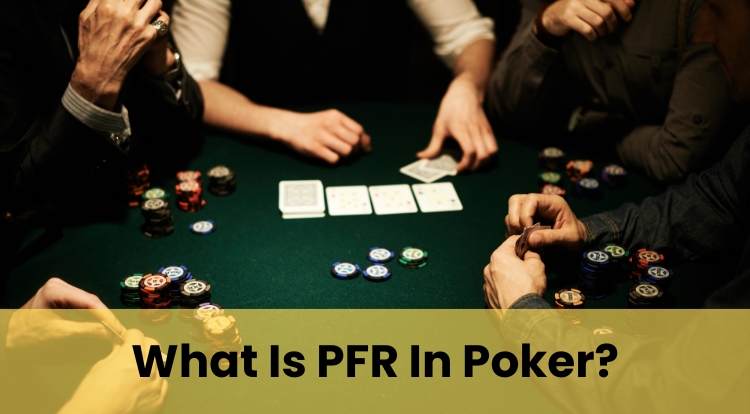
If you're new to poker, you're likely encountering a lot of new terms and abbreviations. One of these you'll often hear is "PFR". But what exactly does it mean, and why should you care?
PFR stands for "Pre-Flop Raise" in poker. It's a simple but crucial concept that tells you how often a player raises before the first round of community cards, or "flop", is dealt.
Knowing a player's PFR can help you understand their style of play. A high PFR indicates an aggressive approach, while a low PFR suggests a more cautious strategy.
In this blog post, we will break down PFR, why it matters, and how you can use it to learn more and potentially improve your own poker game. Whether you're playing casually or aiming to sharpen your skills, understanding PFR can be a valuable part of poker to learn. Let's dive in.
What Does PFR Mean In Poker?
PFR, or "Pre-Flop Raise", is a term used to describe how frequently a poker player raises before the flop is revealed. This ratio is a handy measure to gauge a player's behaviour, giving you a peek into their potential strategies.
Each hand of poker starts with two cards dealt to each player that are hidden from the other players; these are the 'hole cards'. Before any community cards appear, players have the chance to call, raise, or fold based purely on their hand of 2 cards. The PFR stat tracks how often a player chooses to raise during this initial phase.
Understanding PFR is essential because it helps you predict how aggressive a player might be. A high PFR means a player raises often, possibly indicating confidence in their cards or a strategy of betting early in an effort to pressurise opponents. Conversely, a low PFR might reveal someone who prefers to proceed with caution.
By observing PFR, you can adjust your strategy accordingly. If your opponent raises frequently, you might tread carefully. If they rarely raise, you might decide to take advantage of their cautious approach.
Understanding the concept of PFR can be a useful step in advancing your poker skills, as it can give you an insight into your opponents' pattern of play.
How Do You Calculate PFR In Poker?
Calculating PFR in poker is straightforward but requires careful observation over multiple hands. Here's how you do it:
Firstly, you'll want to keep track of how many times a player raises before the flop. This means counting each time they choose to raise their bet during this initial stage of the game.
Next, you need to look at the total number of hands that have been played. You can start tracking this from the beginning of the game or whenever you decide to start paying attention.
To calculate the PFR, divide the number of times a player raises by the total hands they've played. Then, multiply this result by 100 to get a percentage.
For example, if a player has raised pre-flop 20 times out of 100 hands, their PFR would be 20%.
This percentage helps you understand how often a player raises, giving insights into their playing style. Remember, though, that PFR is just one piece of the puzzle when assessing or trying to read your opponents.
What Is a Good PFR In Poker?
Determining a "good" PFR in poker can vary depending on the type of game and the opponents you face. However, there are general guidelines that can help.
Typically, a PFR of around 15-20% is considered balanced in many games. This means you're raising with a range of hands that are strong enough to play aggressively but not so many that you're easily caught bluffing.
A PFR on the lower end, like 10-15%, might suggest a more conservative approach. Here, you're likely raising with the strongest hands, waiting for solid opportunities.
On the higher end, a 20-25% PFR indicates a more aggressive style. This could mean you're frequently betting early in the pursuit of putting pressure on other players.
Remember, what constitutes a "good" PFR also depends on adapting to your opponents. If they're playing cautiously, you might succeed with a higher PFR, taking advantage of their hesitance.
Ultimately, a good PFR is one that aligns with your overall strategy and successfully adapts to the dynamics of each game. It's about finding the right balance between being too passive and overly aggressive.
Is PFR Higher Than VPIP?
To understand whether PFR is higher than VPIP, it's helpful to know what VPIP means. VPIP stands for "Voluntarily Put Money In Pot". It measures how often a player chooses to bet or call when they don't have to.
Typically, VPIP is almost always higher than PFR. This is because VPIP includes any action where a player puts money into the pot voluntarily, including calling and raising. In contrast, PFR only accounts for raises before the flop.
For instance, if a player enters a hand by either calling or raising, it contributes to their VPIP. But only raising affects their PFR.
Imagine a player who decides to play 30 out of 100 hands, calling on 15 occasions and raising on 15. In this case, their VPIP would be 30%, but their PFR would only be 15%.
This means that while both stats are useful, they serve different purposes. VPIP gives a sense of how active a player is, while PFR helps gauge their aggression. Together, they provide a fuller picture of a player's strategy on the table.
**The information provided in this blog is intended for educational purposes and should not be construed as betting advice or a guarantee of success. Always gamble responsibly.
